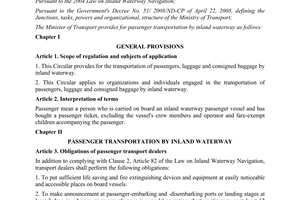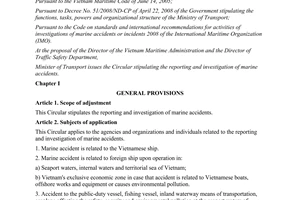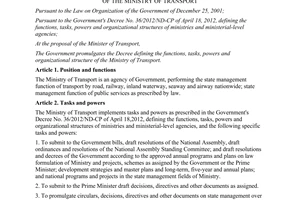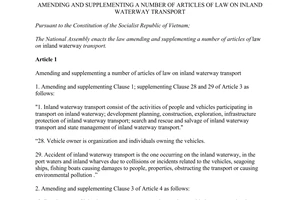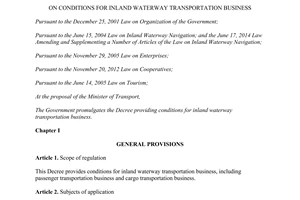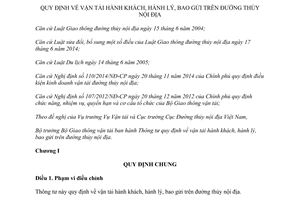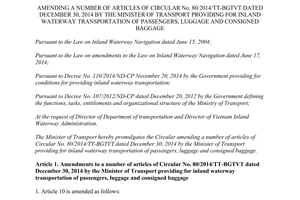Nội dung toàn văn Circular No. 80/2014/TT-BGTVT inland waterway transportation of passengers luggage checked baggage
|
THE MINISTRY OF
TRANSPORT |
THE SOCIALIST
REPUBLIC OF VIETNAM |
|
No. 80/2014/TT-BGTVT |
Hanoi, December 30, 2014 |
CIRCULAR
STIPULATING THE INLAND WATERWAY TRANSPORTATION OF PASSENGERS, LUGGAGE AND CHECKED BAGGAGE
Pursuant to the Law on Inland Waterway Transportation dated June 15, 2004;
Pursuant to the Law on amendments and modifications to several articles of the Law on Inland Waterway Transportation dated June 17, 2014;
Pursuant to the Law on Tourism dated June 14, 2005;
Pursuant to the Government’s Decree No. 110/2014/NĐ-CP dated November 20, 2014 on stipulating the business conditions for inland waterway transportation;
Pursuant to the Government’s Decree No. 107/2012/NĐ-CP dated December 20, 2012 on defining the functions, tasks, powers and organizational structure of the Ministry of Transport;
At the request of the Director of the Transport Department and the Director of the Vietnam Inland Waterway Administration Department
The Minister of Transport hereby promulgates the Circular on stipulating the inland waterway transportation of passengers, luggage and checked baggage.
Chapter I
GENERAL PROVISIONS
Article 1. Scope of application
This Circular shall provide for the inland waterway transportation of passengers, luggage and checked baggage.
Article 2. Applicable entities
This Circular shall apply to Vietnamese and foreign organizations or individuals involving the inland waterway transportation of passengers, luggage and checked baggage.
Article 3. Interpretation of terms
1. Passenger refers to any person going on board inland waterway transports who is not ship crewmen, operators and attendants.
2. Competent authority refers to the entity implementing the state management as assigned to specialized regulatory agencies for inland waterway transportation, including the Vietnam Inland Waterway Department, the Department of Transport and the Regional Inland Waterway Subdepartment.
Chapter II
INLAND WATERWAY TRANSPORTATION OF PASSENGERS, LUGGAGE AND CHECKED BAGGAGE
Article 4. Obligation of an organization or individual rendering the service of inland waterway transportation of passengers, luggage and checked baggage
In addition to implementing regulations laid down in Clause 2 Article 82 of the Law on Inland Waterway Transportation, the carrier is also required to take on the following obligations:
1. Install a full amount of life-saving and fire-fighting equipment at the position that conforms to the ship design standard; as for ships that are built without the design, these equipment items must be installed at the visible and reachable position.
2. Give a notification of any change to the route diagram or itinerary and any change to the departure time within 03 days or 12 hours respectively before such changes take place (except for the transport of passengers crossing a river).
3. Within at least 10 minutes before ships arrive at the destination port or terminal, require the captain to notify passengers of the name of destination port, terminal, stay time and other necessary information (except for the transport of passengers crossing a river).
4. Post the signs of passenger’s rules and regulations, user’s instructions of life-saving and fire-fighting equipment and exit doors in conspicuous places.
5. Treat passengers with courtesy and politeness.
6. Report to the competent authority that has approved the fixed-route passenger transport services within at least 05 days prior to operation termination of each shipping route.
7. Send a monthly data report on the passenger numbers and capacity to the Department of Transport of a city or province where an organization or individual obtains the registration certificate for its shipping business.
Article 5. Procedure that a Vietnamese organization or individual must follow to obtain the approval for fixed-route transportation of passengers, luggage and checked baggage
1. Organization or individual must submit 01 set of documents to apply for the approval for fixed-route inland waterway transportation of passengers, luggage and checked baggage directly, or by post or in any proper mailing form, to the Department of Transport. The application shall include the following documentation:
a) The registration of fixed-route inland waterway transportation of passengers, luggage and checked baggage by completing the form given in the Appendix I enclosed herewith;
b) The written consent from or contract with an organization operating inland waterway ports or terminals used as passenger loading and unloading zones;
c) The plan to operate a shipping route;
d) The authenticated copy (or the copy attached to an original for the collation purpose) of the following documents: Enterprise Registration Certificate or Business Registration Certificate or Certificate of Registration of a business household with the business scope including inland waterway transportation of passengers; Certificate of Conformity of inland waterway transports to technical safety and environmental protection standards.
2. The Department of Transport shall receive and check such applications and take the following actions:
a) As for the application sent directly, if the documentation included in the application is sufficient, the written notification of receipt of such documentation and the appointment note of the application processing result shall be issued; if the documentation included in the application is not sufficient, such application shall be returned, and organizations or individuals being applicants shall be instructed to get their application further completed;
b) As for the application sent by post or in any other mailing form, if the documentation included in the application is not sufficient in accordance with legal regulations, within a period of 02 working days of receipt of such documentation, the Department of Transport must send a written request for getting such application modified or completed to organizations or individuals being applicants;
c) Within a period of 02 working days of receipt of sufficient documentation included in the application in accordance with legal regulations, the Department of Transport must consult with the relevant Maritime Administration Department in case the applicant’s ship moves past navigable waters, and with the Regional Inland Waterway Subdepartment in case the applicant's ship moves past the national inland waterway route. Within a period of 02 working days of receipt of the written request for opinions offered by the Department of Transport, Maritime Administration Department or Regional Inland Waterway Subdepartment must make a written response to that request;
d) Within a period of 03 working days of receipt of opinions offered by Maritime Administration Department or Regional Inland Waterway Subdepartment, the Department of Transport shall send a written consent according to the form given in the Appendix II enclosed herewith to organizations or individuals rendering the service of fixed-route inland waterway transportation of passengers, luggage and checked baggage. In case of refusal, a written response with clear reasons for such refusal must be made.
Article 6. Procedure that a foreign-invested organization or individual must follow to obtain the approval for fixed-route transportation of passengers, luggage and checked baggage
1. Organization or individual must submit 01 set of documents to apply for the approval for fixed-route inland waterway transportation of passengers, luggage and checked baggage directly, or by post or in any proper mailing form, to the Regional Inland Waterway Subdepartment. The application shall include the following documentation:
a) The registration of fixed-route inland waterway transportation of passengers, luggage and checked baggage by completing the form given in the Appendix I enclosed herewith;
b) The written consent from or contract with an organization operating inland waterway ports or terminals used as passenger loading and unloading zones;
c) The plan to operate a shipping route;
d) The authenticated copy (or the copy attached to an original for the collation purpose) of the following documents: Investment Certificate in which the business scope including inland waterway transportation of passengers is registered; Certificate of Registration of the inland waterway transport; Certificate of Conformity of the inland waterway transport to technical safety and environmental protection standards.
2. The Regional Inland Waterway Subdepartment shall receive and check such application and take the following actions:
a) As for the application sent directly, if the documentation included in the application is sufficient, the written notification of receipt of such documentation and the appointment note of the application processing result shall be issued; if the documentation included in the application is not sufficient, such application shall be returned, and organizations or individuals being applicants shall be instructed to get their application further completed;
b) As for the application sent by post or in any other mailing form, if the documentation included in the application is not sufficient in accordance with legal regulations, within a period of 02 working days of receipt of such documentation, the Regional Inland Waterway Subdepartment must send a written request for getting such application modified or completed to organizations or individuals being applicants;
c) Within a period of 02 working days of receipt of sufficient documentation included in the application in accordance with legal regulations, the Regional Inland Waterway Subdepartment must consult with the relevant Maritime Administration Department in case the applicant’s ship moves past navigable waters, and with the Department of Transport in case the applicant's ship moves past the local inland waterway route. Within a period of 02 working days of receipt of the written request for opinions offered by the Regional Inland Waterway Subdepartment, the Maritime Administration Department or Regional Inland Waterway Subdepartment must make a written response to that request;
d) Within a period of 03 working days of receipt of opinions offered by the Department of Transport or Maritime Administration Department, the Regional Inland Waterway Subdepartment shall send a written consent according to the form given in the Appendix II enclosed herewith to organizations or individuals rendering the service of fixed-route inland waterway transportation of passengers, luggage and checked baggage. In case of refusal, a written response with clear reasons for such refusal must be made.
Article 7. Procedure for permission to carry passengers across the river
1. Organization or individual must submit 01 set of documents to apply for the permission to carry passengers across the river directly, or by post or in any proper mailing form, to the Department of Transport. The application shall include the following documentation:
a) The registration of shipping of passengers across the river by completing the form given in the Appendix I issued together with this Circular;
b) The written consent from or contract with an organization operating river ferry terminals used as passenger loading and unloading zones;
c) The authenticated copy (or the copy attached to an original for the collation purpose) of the following documents: Enterprise Registration Certificate or Business Registration Certificate or Certificate of Registration of a business household with the business scope including inland waterway transportation of passengers; Certificate of Conformity of the inland waterway transport to technical safety and environmental protection standards (if any).
2. The Department of Transport shall receive and check such application and take the following actions:
a) As for the application sent directly, if the documentation included in the application is sufficient, the written notification of receipt of such documentation and the appointment note of the application processing result shall be issued; if the documentation included in the application is not sufficient, such application shall be returned, and organizations or individuals being applicants shall be instructed to get their application further completed;
b) As for the application sent by post or in any other mailing form, if the documentation included in the application is not sufficient in accordance with legal regulations, within a period of 02 working days of receipt of such documentation, the Department of Transport must send a written request for getting such application modified or completed to organizations or individuals being applicants;
c) Within a period of 02 working days of receipt of sufficient documentation included in the application in accordance with legal regulations, the Department of Transport must consult with the relevant Maritime Administration Department in case the applicant’s ferry moves past navigable waters, and with the Regional Inland Waterway Subdepartment in case the applicant's ferry moves past the national inland waterway route;
d) Within a period of 03 working days of receipt of opinions offered by the Maritime Administration Department or Regional Inland Waterway Subdepartment, the Department of Transport shall send a written consent according to the form given in the Appendix II enclosed herewith to organizations or individuals rendering the service of shipping passengers across the river. In case of refusal, a written response with clear reasons for such refusal must be made.
Article 8. Grant of the license plate to cruise ships
1. Organization or individual that keeps the written consent to fixed-route inland waterway transportation of passengers, luggage and checked baggage from the competent authority shall be granted the license plate used for their cruise ship.
2. The license plate shall be granted to the cruise ship on receipt of opinions from the central competent authority for tourism.
Chapter III
PASSENGER TICKET
Article 9. Passenger ticket, ticket sale, ticket check
1. The passenger ticket shall be printed or published by the carrier according to the form given in the Appendix III enclosed herewith.
2. Any ship fare, though newly published or changed, must be made known to the public through the website of the carrier or through mass media for 03 consecutive days and the new fare shall be applicable after 15 days therefrom; must be posted in a public area at a passenger loading or unloading terminal.
3. Organization or individual rendering the service of fixed-route passenger transportation is able to run their own ticket business or designate other organization or individual to operate inland waterway ports or terminals, or other persons to sell tickets.
4. Organization or individual rendering the service of fixed-route inland waterway transportation shall make a public notice of the fare, opening and closing hours of the ticket counter and passenger lounge. As for fixed-route passenger transportation, the closing hour of the ticket counter shall be at least 15 minutes prior to the departure time.
5. The number of tickets sold for each trip shall not be permitted to exceed the number of passengers stipulated by the register agencies and shall be shown in the list of passengers according to the form given in the Appendix IV enclosed herewith.
6. Organization or individual rendering the service of fixed-route passenger transportation must check tickets when passengers disembark; prevent the excess number of disembarking passengers; punctually deal with any mistake about the passenger ticket.
Article 10. Passenger fare exemption or discount
1. Children under 1 year of age shall be exempt from passenger fares but have to seat in their traveling companion’s lap.
2. The carrier shall adhere to the statutory requirements for fare discount and actual conditions in order to specify the rate of fare discount and exemption for passengers.
Article 11. Procedure for dealing with passenger tickets
1. A passenger who is carried past an inland waterway port or terminal defined in the passenger ticket must buy another ticket for the extra shipping distance.
2. If a passenger wishes to disembark at the passenger port or terminal closer than the one specified in the passenger ticket, the fare paid for the distance at which that passenger is not carried shall not be refunded.
3. The passenger who returns the passenger ticket within at least 01 hour before the departure time shall receive a refund of 90% of the passenger fare.
4. If the passenger who has already bought the passenger ticket but turned up later than the predetermined departure time without any prior notification sent to the carrier or ticker seller, the following regulations shall be implemented:
a) If that passenger wishes to take the next trip, the carrier shall be responsible for arranging that passenger to go on the next trip and require that passenger to pay additional 50% of the passenger fare;
b) The passenger who wishes not to take the next trip shall not be permitted to receive the fare refund.
5. If the passenger who has already bought the passenger ticket but turned up after the ship has departed and that passenger has also sent the notification to the carrier or ticker seller (via telephone, telegram, Fax or Email) within 02 hours prior to the predetermined departure time, the following regulations shall be implemented:
a) If that passenger wishes to take the next trip, the carrier shall be responsible for arranging that passenger to go on the next trip and require that passenger to pay additional 20% of the passenger fare;
b) The passenger who wishes not to take the next trip and returns the ticket shall receive a refund of 90% of the passenger fare.
Chapter IV
TRANSPORTATION AND STORAGE OF CHECKED BAGGAGE
Article 12. Checked baggage or consignment
1. Each passenger shall be allowed 20 kg of hand baggage upon payment of the hand baggage fee.
2. Regulations on the checked baggage or consignment:
a) Each checked baggage has the size of less than 1.2m length x 0.7m width x 0.7m height; the hand baggage weight is not greater than 50kg per each checked bag or parcel;
b) The passenger shall be charged with the shipping fee. If the checked baggage is not in excess of the regulatory weight (20 kg), that checked baggage shall be exempted from the checked baggage fee.
c) In addition to the regulations laid down at Point a, b Clause 2 of this Article, the passenger who has the checked baggage shall be subjected the following regulations: A passenger who has bought the ticket specifying that passenger's arrival port or terminal shall claim their checked baggage at this port or terminal; the checked baggage must be shipped by the same transport which carries the consignor of such checked baggage, even if the transport is changed during a journey.
3. The passenger shall not be allowed to take on board the following luggage or checked baggage:
a) Remains (except for urns for cremated remains);
b) Animal that weights equal to or less than 10kg per each, or has stinky odor;
c) Goods with stinky and musty smells;
d) Bulky items or those that can protrude into the aisle.
Article 13. Checked baggage or consignment safekeeping
1. The passenger whose checked baggage is in excess of the regulatory allowance shall have to make extra payment for such excess checked baggage and deliver it to the carrier before the departure time.
2. The consignor of the checked baggage or consignment must submit the manifest specifying items, quantity, weight, value; name, address of the consignor and consignee. This manifest shall be made into at least 02 copies. Each of 02 copies shall be kept by the consignee and the carrier. When necessary, more copies may be made.
3. The consignor of the checked baggage or consignment shall be responsible for checking the legality of these checked baggage items, and sending all necessary copies of required documents under the provisions of laws to the carrier.
4. The carrier shall be responsible for checking the package, quantity, item code and sign their name on this item manifest; depending on the capacity of their transport, warehouse or terminal, the carrier shall decide whether they can ship this checked baggage or consignment.
Article 14. Checked baggage or consignment claim
1. The passenger who has the checked baggage or consignment is required to show the passenger ticket or fee payment receipt before claiming their checked-in baggage.
2. The consignee of the checked baggage or consignment must present the fee payment receipt, commodity manifest and personal documents. If the consignee authorizes other person to claim the checked baggage or consignment, the written authorization must be submitted in accordance with laws. If the claim of the checked baggage or consignment exceeds the permitted time agreed upon between the consignor and consignee, the warehousing fee must be paid.
3. The person who claims the checked baggage or consignment must recheck it at the baggage claim area; after completion of such baggage claim, the carrier shall not be responsible for any loss or damage to that checked baggage or consignment.
Chapter V
DISPUTE SETTLEMENT AND INDEMNITY
Article 15. In the event of the carrier’s default
1. In case the transport fails to depart on the right schedule, the passenger has to wait overnight, the carrier shall have to arrange the place where the passenger can eat and rest as well as be liable to all incurred expenses; if the passenger refuses to continue their journey and return the ticket, the carrier shall be obliged to refund any fare or charge to the passenger.
2. In case the transport is out of order during a journey and the journey has to end, the captain shall find all possible measures to take the passenger to the nearest passenger port or terminal in a safe manner, notify the carrier of the situation and take the following actions:
a) If the passenger has to wait overnight, the carrier must arrange the place where the passenger may eat and rest as well as all incurred expenses;
b) If that passenger does not wish to wait for the next journey, the carrier is required to refund the fare and charge in proportion to the remaining distance at which the passenger would travel;
c) If the carrier is able to arrange another transport to carry the passenger back to the original departure terminal, the carrier shall refund all of the fare or charge to the passenger.
Article 16. In the event of force majeure
1. In the event of temporary delay, the carrier must notify the passenger of such delay when the transport has not yet departed; if the journey is cancelled, the carrier must refund all of the fare or charge to the passenger.
2. When the transport is running:
a) If the transport has to run on the longer route, the carrier is not allowed to collect any additional fare or charge from the passenger.
b) In case there is any transloading of passengers, luggage and checked baggage, the carrier must undertake all transloading activities and be liable to all incurred expenses;
In case it is impossible to continue the voyage, and the transport has to disembark at the nearest or departing terminal, the passenger shall not be liable to any additional fare or charge for the distance at which the passenger is shipped back; the carrier shall be liable to the fare or charge in proportion to the distance at which the passenger has not yet traveled.
Article 17. Checked baggage during the journey
1. In case the checked baggage is fired, leaked or damaged during a journey, the carrier is obliged to notify and collaborate with the passenger who is the owner of such baggage to take immediate measures to control these accidents to protect the passenger, goods and transport. When taking such controlling measures, if there is any damage that may arise, the written confirmation signed by the owner of such baggage and representative of the passengers must be made. All incurred expenses shall be covered by the defaulting party. If both parties are found with no default, each party shall be responsible for their own expenses and loss.
2. As regards any force majeure that may happen, if the carrier realizes that the safety standard is not met, they have the right to move part or all of luggage away from their transport; those who carry their luggage shall have to protect their own luggage; each party shall be solely responsible for their own expenses or loss.
3. In case the shipping channel is congested, the carrier must notify and collaborate with the passenger in taking the following measures:
a) If the carrier realizes that such congestion may cause the passenger to wait, affect the passenger’s trip and health, the carrier must arrive at the nearest passenger terminal and help disembark passengers and their luggage; assist the passenger in continuing their trip on another transport. The carrier shall be permitted to collect the fare and charge for the actual distance at which their transport has traveled;
b) In case the transport has to head back to the departing port or terminal, the carrier shall only be entitled to collect the fare and charge for the distance at which their transport has traveled (exclusive of the return-trip ticket);
c) In case there is any transloading of passengers and luggage to avoid the congestion area, the carrier must undertake all transloading activities and be liable to all incurred expenses;
d) In case the transport has to wait until the congestion is solved, the carrier must notify the passenger of this; if the passenger wishes to leave the trip, the sailor must make every effort to get their passenger ashore.
Article 18. Consignment
If there is any change to the consignment in the shipping process, the regulations on inland waterway transportation of cargos must be applied.
Article 19. Indemnity for lost or damaged checked baggage or consignment
1. In case the checked baggage or consignment is damaged, missing or lost through the carrier’s faults, the carrier must pay an indemnity in accordance with the following regulations:
a) In proportion to the predetermined value in case the checked baggage or consignment has declared its value; in case the carrier has proved that the damaged value is actually less than the declared value, the actual damaged value shall be the basis for calculating the indemnity;
b) In proportion to the amount agreed upon between both contracting parties;
c) In proportion to the value defined on the sales invoice and other relevant costs;
d) In proportion to the market price of such cargos defined at the payment date and destination location; in case there is no market price applied to such cargo, the average price of cargos of the same kind and quality defined in the baggage claim area shall serve as the basis for calculating the indemnity;
dd) In case it is impossible to handle the abovementioned case under the provisions of Point a, b, c and Point d Clause 1 of this Article, the following regulations shall take effect: As for the checked baggage, the indemnity amount does not exceed VND 20,000 per 01 kg of lost or damaged checked baggage; as for consignment, the indemnity amount does not exceed VND 20,000 per 01 kg of lost or damaged consignment, and VND 7,000,000 per each lost or damage bag or parcel.
2. If the checked baggage or consignment is partially damaged, missing or lost, the lost, damaged part shall be used to calculate the indemnity; in case such lost or damaged part leads to the damage or loss against all of the checked baggage or consignment, the indemnity for the entire checked baggage or assignment must be paid; the carrier shall have the right to own the number of lost or damaged cargos for which the indemnity is made.
3. In addition to the indemnity stipulated by Clause 1 of this Article, the carrier shall be obliged to refund the passenger or the consignor the fare or fee charged for the lost or damaged checked baggage or consignment.
Article 20. Dispute settlement
1. In the course of inland waterway transportation, if there is any change that may influence the mutual benefit, the on-the-spot record must be made; the record content must specify the time, location, consequence, objective and subjective reasons and handling result verified by the representative of passengers. The record shall be then sent to interested parties.
2. In case the agreement is failed, parties concerned shall have the right to file the Arbitration case or the lawsuit in Court in accordance with laws.
Chapter VI
INVESTIGATION AND ACCIDENT HANDLING PROCEDURE
Article 21. Procedure for handling accidents that may occur at port, terminal or inland waters
Organization, individual involving the procedure for handling accidents that may occur at port, terminal and inland waters under the provisions of Clause 22 Article 1 of the Law on amendments to several articles of the Law on Inland Waterway Transportation dated June 17, 2014 and legislative documents about stipulating the management of inland waterway port or terminal. In case the ship accident takes place but there is no possibility of taking remedial measures, such accident must reported to the Inland Waterway Administration Department for departure and arrival port or terminal, the transport owner and the nearest local authority.
Article 22. Handling of accidents that may happen within seaport waters or navigable channels
Organization, individual involving the handling of the accidents that may happen at seaport waters and shipping channels in accordance with the regulations laid down in the Circular No. 27/2012/TT-BGTVT of the Minister of Transport dated July 20, 2012 on stipulating the reporting and investigation of marine accidents. In case the ship accident occurs without any remedial measure, such accident must be promptly reported to the regional Marine Rescue and Coordination Center in order to arrange rescue and salvage activities.
Article 23. Temporary suspension of passenger transports
The Department of Transport, Inland Waterway Administration Department shall issue the temporary suspension of the transport that has been involved in accidents causing impact on the technical safety standard of the transport and shall allow this transport to resume its operations only if it obtains the certificate of conformity to the technical safety standard from the register authority.
Chapter VII
IMPLEMENTATION
Article 24. Effect
1. This Circular shall come into force from February 15, 2015.
2. The Circular No. 20/2011/TT-BGTVT of the Minister of Transport dated March 31, 2011 on stipulating inland waterway transportation of passengers shall be annulled.
Article 25. Implementation
The Chief of the Ministry Office, the Ministry’s Chief Inspector, the Director of the Vietnam Inland Waterway Department, the Director of the Vietnam Register, the Director of the Vietnam Maritime Administration, the Director of the Department of Transport, the Heads of agencies, organizations or individuals concerned shall be responsible for implementing this Circular./.
|
|
THE MINISTER |
------------------------------------------------------------------------------------------------------
This translation is made by LawSoft and
for reference purposes only. Its copyright is owned by LawSoft
and protected under Clause 2, Article 14 of the Law on Intellectual Property.Your comments are always welcomed


